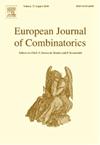Infinitely many minimally non-Ramsey size-linear graphs
IF 0.9
3区 数学
Q1 MATHEMATICS
引用次数: 0
Abstract
A graph is said to be Ramsey size-linear if for every graph with no isolated vertices. Erdős, Faudree, Rousseau, and Schelp observed that is not Ramsey size-linear, but each of its proper subgraphs is, and they asked whether there exist infinitely many such graphs. In this short note, we answer this question in the affirmative.
无穷多个最小非拉姆齐大小线性图
对于没有孤立顶点的每个图H,如果r(G,H)=OG(e(H)),则图G是拉姆齐大小线性的。Erdős, Faudree, Rousseau和Schelp观察到K4不是拉姆齐大小线性的,但它的每个适当子图都是线性的,他们问是否存在无限多个这样的图。在这篇短文中,我们肯定地回答了这个问题。
本文章由计算机程序翻译,如有差异,请以英文原文为准。
求助全文
约1分钟内获得全文
求助全文
来源期刊
CiteScore
2.10
自引率
10.00%
发文量
124
审稿时长
4-8 weeks
期刊介绍:
The European Journal of Combinatorics is a high standard, international, bimonthly journal of pure mathematics, specializing in theories arising from combinatorial problems. The journal is primarily open to papers dealing with mathematical structures within combinatorics and/or establishing direct links between combinatorics and other branches of mathematics and the theories of computing. The journal includes full-length research papers on important topics.

 求助内容:
求助内容: 应助结果提醒方式:
应助结果提醒方式:


